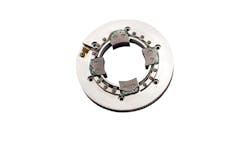Measuring It All: Position Sensors Get an Upgrade
Eddy-current position sensors, which measure shaft displacement in rotating machinery, have been around for many years as they offer manufacturers high-linearity, high-speed measurements, and high resolution. Most eddy-current sensors on the market only measure the distance between the sensor and the shaft—so how do manufacturers measure the displacement of the shaft if it is tangential to the sensor? Alexei Filatov, Principal Research Engineer for Calnetix Technologies invented a novel eddy-current position sensor that measures both of these factors, as well as much more, in a single sensor. New Equipment Digest spoke with Alexei and Larry Hawkins, Co-Founder and Director of Technology for Magnetic Bearings at Calnetix Technologies to find out how this sensor works and how it will benefit manufacturers.
New Equipment Digest (NED): What is the Eddy-Current Position Sensor and what does it do?
Dr. Alexei Filatov/Larry Hawkins (AF/LH): The Eddy-Current Position Sensor technology allows non-contact detection of an object’s position in the space. In particular, they are often used to measure the static and dynamic shaft displacement in rotating machinery. At least some part of the object (shaft) must be electrically conductive and is typically referred to as the “sensor target.” In generic terms, the operational principle of the sensor always includes exposing the sensor target to high-frequency electromagnetic fields. These fields induce eddy currents in the target, which produce their own electromagnetic field, altering the original field. The amount of the field alteration depends on the distance between the target and the source of the original field and is used for the object position detection. In most designs, changes in the inductance of the electrical coil generating the original field are used as a measure of the distance between the object and the coil.
NED: Calnetix just received a patent for this technology. Can you explain what the new technology is and why it was developed?
AF/LH: Calnetix has developed a novel eddy-current position sensor with unique properties, which include:
- “Slide-by” position measurements–the sensor can detect not only a normal distance between the sensor and an object as other eddy-current position sensors do but also displacements of an object when it moves tangentially to the sensor (“slides-by”).
- No coaxial cables required as in other eddy-current sensors–uses twisted pairs, which are much easier to work with and bring through machine interfaces.
- Low cost.
The primary motivation for this technology development was the need for a better performing, more highly reliable and lower-cost alternative to the other types of non-contact position sensors available today.
NED: Is this sensor a part of a larger product offered from Calnetix or is it a standalone product? If so, can you please explain what that larger product is?
AF/LH: The primary application of the new position sensor is a part of Calnetix Magnetic Bearing Systems, but it can also be used as a standalone product. Calnetix Magnetic Bearing Systems provide non-contact suspension of high-speed rotors in rotating machinery, including gas compressors and expanders, motors, generators, flywheel energy storage systems, etc. The sensor provides the feedback control input for the position control loop of the magnetic bearing, allowing it to control the position of a rotating shaft with a magnetic field.
NED: What are the main features of the position sensor?
AF/LH: The unique design features of the new position sensor include:
- Two-coil design (separate excitation coil and sensing coil) with both coils implemented as interconnected traces on several layers of a single flexible Printed Circuit Board (PCB). In contrast, most commercial eddy-current position sensors use a single cylindrical coil wound with a fine enameled magnet wire. Flexible PCBs are shaped to follow the sensor target profile so that all the coil turns are located close to the target, maximizing raw sensor gain. The other advantages of the two-coil design include better linearity and thermal stability. Using coils made with flexible PCB technology dramatically improves sensor manufacturability.
- Composite backiron—Flexible PCBs with sensor coils are backed by a composed backiron made of epoxy filled with iron powder. The backiron serves two purposes:
- Provides structural support for the flexible PCBs.
- Increases sensor gain by reducing the reluctance of the magnetic flux path, thanks to the magnetic properties of the iron powder.
Because the composite backiron is molded rather than machined, it is very well suited for low-cost, high-volume production.
- Resonance electronics drive—High-frequency electrical current in the sensor excitation coil is generated by making the coil a part of an amplified LCR resonance loop with positive feedback. Another negative-feedback control loop is used to maintain the constant amplitude of the excitation current. This approach allows the generation of a large, purely sinusoidal excitation current with minimal power supply voltage.
NED: How is this technology different from similar position sensors already on the market? What specific advantages does it provide to users?
AF/LH: The sensor delivers a combination of the following advantageous properties not found collectively in prior technologies:
- “Slide-by” position measurements – the sensor can detect not only a normal distance between the sensor and a shaft as other eddy-current position sensors do but also displacements of the shaft when it moves tangentially to the sensor (“slides-by”). In Magnetic Bearing applications, this means that axial shaft motion, required for the control of a thrust magnetic bearing, can be measured from a radial direction. This provides significant assembly and often cost advantages relative to other sensing technologies that require a sensor target surface normal to the rotational axis to measure axial motion.
- The sensor target consists of solid steel such that the primary shaft surface can be the target with no added sleeves or laminations. In contrast, other common non-contact electromagnetic position sensors, known as “reluctance” or “inductive”, have the target composed of electrically-isolated steel laminations. Such laminated targets are much more difficult to make, and the sensor accuracy can be affected by the target machining—smearing and shorting between the laminations during machining leads to significant sensor errors.
- Position sensing along two radial and one axial axes in rotational systems can be implemented in a single assembly with a minimal number of external wires, as often needed in Magnetic Bearing Systems.
- No coaxial cables required as in other eddy-current sensors – it uses twisted pairs, which are much easier to work with and bring through machine interfaces.
- Excellent linearity over wide displacement range.
- High operating temperature potential (>225 °C).
- Much lower operating frequency than in other eddy-current sensors (200kHz instead of >500kHz, typically MHz) results in much simpler electronics.
- Higher operating frequency than in reluctance sensors (200kHz instead of tens of kHz) results in higher bandwidth and better rejection of electromagnetic interference with other system components switching at tens of kHz (such as switching amplifiers and motor drives).
- Fewer components inside the sensor (no laminations, no wire-wound coils, no lamination-to winding isolation, no magnet wire to lead wire splices).
- Well suited for high-volume production.
NED: What was the biggest challenge in developing the new position sensor?
AF/LH: Achieving the necessary combination of a large gain, high linearity and large measurement range in the “slide-by” mode was the biggest challenge. This has not been achieved in any other eddy-current position sensor.
Dr. Alexei Filatov
– Dr. Alexei Filatov is a Principal Research Engineer at Calnetix Technologies, and his main area of expertise is magnetic bearings and their applications in rotating machinery. Dr. Filatov has over 25 years of experience working on various types of magnetic bearings, ranging from Superconductive to Electrodynamic and Active Magnetic Bearings. He has 16 U.S. and International patents issued on magnetic bearing designs, as well as numerous publications in peer-reviewed journals and conference proceedings.
Larry Hawkins
– Mr. Larry Hawkins is a Co-Founder and the Director of Technology for Magnetic Bearings at Calnetix Technologies. Mr. Hawkins has played a key role in the company’s research and development efforts since Calnetix’s inception in 1998. He has over 35 years of industrial experience, holds multiple patents and publications in the high-speed turbomachinery field, and is recognized globally for his contributions to rotordynamics and magnetic bearing technology.
About the Author
Laura Davis
Editor-in-Chief, New Equipment Digest
Laura Davis is the editor in chief of New Equipment Digest (NED), a brand part of the Manufacturing Group at EndeavorB2B. NED covers all products, equipment, solutions, and technology related to the broad scope of manufacturing, from mops and buckets to robots and automation. Laura has been a manufacturing product writer for eight years, knowledgeable about the ins and outs of the industry, along with what readers are looking for when wanting to learn about the latest products on the market.


